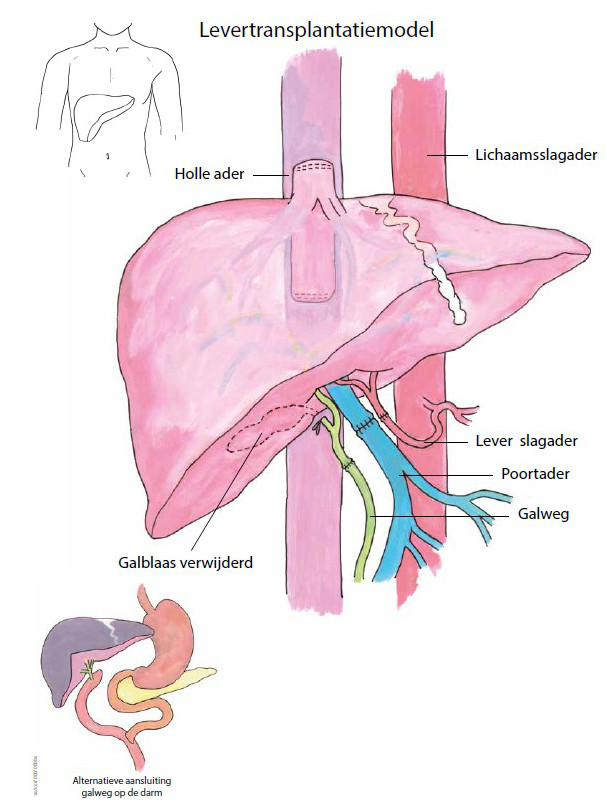Liver transplant
The liver
The liver is a large organ in your body, weighing between 1200 and 1500 grams. It is located in the upper right abdomen. The liver receives deoxygenated blood, rich in nutrients, from the intestines through the portal vein (portal vein), and oxygenated blood through the hepatic artery (hepatic artery). Once the blood has passed through the liver, it is returned to the heart through the inferior vena cava (vena cava).
The main functions of the liver
- The liver ensures that sugar is available 24 hours a day, although we eat a limited number of times a day.
- The liver plays an important role in the production and conversion of proteins, vitamins and substances that enable the blood to clot.
- The liver is responsible for the construction, storage and breakdown of energy-rich substances.
- The liver is responsible for making all kinds of toxic substances harmless, such as medicines and alcohol. One of the substances is bilirubin, which is produced by the breakdown of red blood cells. When the liver is not functioning properly, bilirubin builds up in the skin and mucous membranes. These turn yellow and the patient has jaundice.
- The formation of bile, a fluid that allows fat-soluble substances to leave the body through the liver and that fats and fat-soluble vitamins are obtained from food.
What is a liver transplant?
A liver transplant is a major operation in which your diseased, malfunctioning liver is removed. This will be replaced by a new liver, which will be replaced in the same place. This operation is also known as an “orthotopic liver transplant”. The operation takes on average ± 8 hours, this varies from person to person. There is a scar on the abdomen as a result of the surgery, an incision starting at the sternum and down the bottom of the right costal margin.
To prevent the donor liver from being rejected by the body, you will take medication for the rest of your life. In addition, you must remain under the supervision of a transplant center.
Liver transplants are possible in adults and in children. Only adult liver transplants are performed at Erasmus MC in Rotterdam.
Why is a liver transplant necessary?
The liver is an organ that cannot be replaced by therapies or drugs. If the liver stops functioning, the body is in mortal danger and the only solution is a liver transplant. There are various liver diseases for which there are treatments to suppress the symptoms, but the cause is not removed.
Many liver diseases cause long-term liver damage resulting in liver cirrhosis. Liver cells die and are replaced by fibrous connective tissue. Due to this change, the functioning of the liver continues to deteriorate.
When the liver does not function properly and can no longer perform its tasks adequately, the following symptoms can occur:
- severe fatigue, weakness and lethargy
- jaundice
- itch
- dark urine
- discolored stools
- consciousness disorders, confusion and coma
- accumulation of fluid in the abdomen (ascites)
- vomiting blood (due to rupture of varicose veins in the esophagus)
- bleeding tendency
A liver transplant is the only solution in this life-threatening situation.

Who is a candidate for a liver transplant?
It is determined whether someone is eligible for a liver transplant on the basis of certain nationally established conditions. These conditions are as follows:
- end-stage liver disease
- no other treatment is possible
- there is a limited life expectancy
- there are no other serious physical conditions that constitute an obstacle to a transplant
- there is no active alcohol and drug use
- the patient understands what a liver transplant entails and is also able to follow the rules of life after surgery
Risks with a liver transplant
There are risks associated with a liver transplant. Firstly, the liver transplant itself is a major and major operation. Surgical technical problems can arise after the operation. There is, among other things, a risk of bleeding, bile leakage, or thrombosis in an important hepatic artery (hepatic artery). In addition, there is a risk of infection and rejection of the liver by the body, especially in the first 4 weeks. In the longer term, there are the side effects of the drugs that you must continue to take to prevent rejection permanently. The risks of a liver transplant are therefore not small. Once the screening has been completed and you give permission for the liver transplant, the gastrointestinal and liver doctor will discuss the risks and possible complications with you. In recent years, there have been many advances in drug therapy and surgical technology which have greatly improved the results of the transplants.